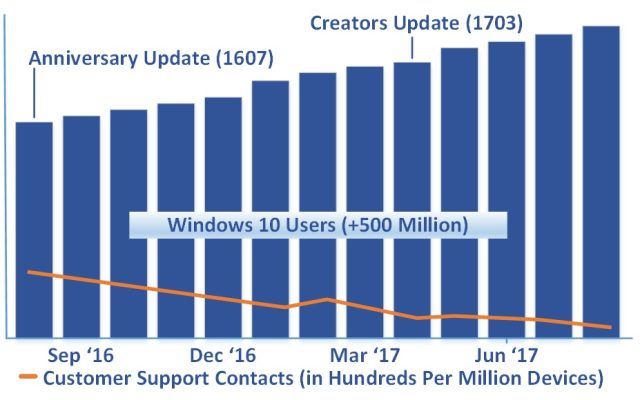
Windows 10 is getting better and better, Microsoft insists, as it works to build confidence in the operating system in the run up to the next major update. The company says that the Creators Update (version 1703) has seen a 39 percent drop in driver and operating system stability issues relative to the Anniversary Update (version 1607).
Performance is better too; according to Microsoft's telemetry, boot time is 13 percent faster, logging in 18 percent faster, and facial recognition 30 percent faster. There are incremental improvements in battery life, too, from 2.5 to 5 percent longer life watching videos in the Movies & TV app, and a 17 percent improvement in the Edge browser.
The subtext to these numbers is that Microsoft is still working to convince customers, especially corporate customers, that the new Windows development model is working, and that the company is hearing the feedback. The Anniversary Update was rapidly deployed, and it hit a number of issues soon after launch, causing problems for both consumers and enterprise users alike.

Microsoft had to examine how it handled deployments, and the result is a much more conservative, much more careful staged deployment. Five months after the Creators Update was released, it was only on two-thirds of Windows machines, compared to 85 percent at the same stage for the Anniversary Update. This less-aggressive rollout seems to have done a good job; there have been far fewer complaints about the Creators Update, and in general it has worked as it should.
The numbers also send a message that the updates are worthwhile: even if the major features of each update aren't of interest, the improved stability, battery life, and security capabilities are valuable and make updates worth having. This is particularly important for Enterprise customers, as it means they shouldn't be tempted by the Long Term Servicing Channel version of Windows. This version doesn't receive the six monthly updates and instead uses the traditional, familiar ten year servicing model that previous versions of Windows used. On the basis of this data, the last LTSC version (which coincided with the Anniversary Update) is meaningfully less stable and efficient than the current mainstream version.
Underpinning the slower rollout and stability data is, of course, the contentious collection of telemetry data. Microsoft uses the data to, among other things, detect deployment issues with the Creators Update and, if necessary, delay its rollout to problematic hardware, drivers, or other software. The Fall Creators Update will give enterprises a little more control over which telemetry data is collected, but a built-in way to disable telemetry collection entirely remains out of reach for regular consumers.
reader comments
161